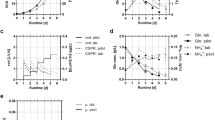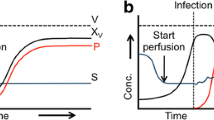Abstract
We carried out the first simulation on multi-stage continuous high cell density culture (MSC-HCDC) to show that the MSC-HCDC can achieve batch/fed-batch product titer with much higher productivity to the fed-batch productivity using published fermentation kinetics of lactic acid, penicillin and ethanol. The system under consideration consists of n-serially connected continuous stirred-tank reactors (CSTRs) with either hollow fiber cell recycling or cell immobilization for high cell-density culture. In each CSTR substrate supply and product removal are possible. Penicillin production is severely limited by glucose metabolite repression that requires multi-CSTR glucose feeding. An 8-stage C-HCDC lactic acid fermentation resulted in 212.9 g/L of titer and 10.6 g/L/h of productivity, corresponding to 101 and 429% of the comparable lactic acid fed-batch, respectively. The penicillin production model predicted 149% (0.085 g/L/h) of productivity in 8-stage C-HCDC with 40 g/L of cell density and 289% of productivity (0.165 g/L/h) in 7-stage C-HCDC with 60 g/L of cell density compared with referring batch cultivations. A 2-stage C-HCDC ethanol experimental run showed 107% titer and 257% productivity of the batch system having 88.8 g/L of titer and 3.7 g/L/h of productivity. MSC-HCDC can give much higher productivity than batch/fed-batch system, and yield a several percentage higher titer as well. The productivity ratio of MSC-HCDC over batch/fed-batch system is given as a multiplication of system dilution rate of MSC-HCDC and cycle time of batch/fed-batch system. We suggest MSC-HCDC as a new production platform for various fermentation products including monoclonal antibody.





Similar content being viewed by others
Abbreviations
- B :
-
Bleed ratio (dimensionless)
- D :
-
Dilution rate (/h), D t for MSC-HCDC system, D i for each reactor of MSC-HCDC, D f dilution rate increase by feed stream for each reactor
- k d :
-
Specific death rate (/h)
- m x :
-
Maintenance coefficient
- P :
-
Product titer (g/L)
- PD:
-
Productivity (g/L/h)
- PR:
-
Productivity ratio (dimensionless)
- Q :
-
Feed flow rate (main stream) (L/h)
- q :
-
Feed flow rate (branched stream) (L/h)
- qp/x,\( \overline{q} \)p/x:
-
Specific, average productivity of cells (g/g/h)
- r P :
-
Product formation rate (g-product/L/h)
- S :
-
Substrate concentration (g/L)
- V :
-
Reactor volume (L)
- w :
-
Volume ratio (dimensionless)
- X,\( \overline{X} \):
-
Cell concentration, average cell concentration (g/L), X = 100 g/L (lactic acid, ethanol) and X = 40 and 60 g/L (penicillin) were used
- Y :
-
Yield value
- μ :
-
Specific growth rate (/h)
- β :
-
Flow ratio of the top effluent and filtrate (dimensionless)
- γ :
-
Filtration ratio in the cell filtering unit (dimensionless)
- θ :
-
Cycle or residence time of fermentation system (h)
- 0:
-
Initial value
- b, fb:
-
Batch, fed-batch system
- c:
-
Continuous
- f:
-
Feed stream
- hcdc:
-
High cell-density culture
- i :
-
Number of optional stages
- j :
-
Number of optional stages
- n :
-
Number of stages
- t :
-
Total value for D, P, PD, V, Q or θ
- HRT:
-
Hydraulic retention time
- SRT:
-
Solid retention time
- Mab:
-
Monoclonal antibody
- C-HCDC:
-
Continuous high cell-density culture
- SSC-HCDC:
-
Single-stage continuous high cell-density culture
- MSC-HCDC:
-
Multistage continuous high cell-density culture
- PHB:
-
Polyhydroxybutyric acid
- B/FB:
-
Batch or fed-batch
- FB:
-
Fed-batch
References
Cooney CL (1983) Bioreactors: design and operation. Science 219:728–733
Shuler ML, Kargi F (2002) Bioprocess engineering. PH PTR, New Jersey
Stephanopoulos G (2007) Challenges in engineering microbes for biofuels production. Science 315:801–804
Otten LG, Quax WJ (2005) Directed evolution: selecting today’s biocatalysts. Biomol Eng 22:1–9
Reetz MT, Carballeira JD (2007) Iterative saturation mutagenesis (ISM) for rapid directed evolution of functional enzymes. Nat Protoc 2:891
Xie LZ, Wang DIC (1996) High cell density and high monoclonal antibody production medium design and rational control in a bioreactor of outstanding interest. Biotechnol Bioeng 51:725–727
Lee SY (1996) High cell-density culture of Escherichia coli. Trends Biotechnol 14:98–105
Lee CW, Chang HN (1987) Kinetics of ethanol fermentations in membrane cell recycle fermentors. Biotechnol Bioeng 29:1105–1112
Vick Roy TB, Blanch HW, Wilke CR (1982) Lactic acid production by Lactobacillus delbreuckii in a hollow fiber fermenter. Biotechnol Lett 4:483–488
Robertson CR, Kim IH (1985) Dual aerobic hollow-fiber bioreactor for cultivation of Streptomyces aureofaciens. Biotechnol Bioeng 27:1012–1020
Chung BH, Chang HN, Kim IH (1987) Rifamycin B production by Nocardia mediterranei immobilized in a dual hollow fibre bioreactor. Enzyme Microb Tech 9:345–349
Deshpande RR, Heinzle E (2004) On-line oxygen uptake rate and culture viability measurement of animal cell culture using microplates with integrated oxygen sensors. Biotechnol Lett 26:763–767
Kim BS, Lee SC, Lee SY, Chang HN, Chang YK, Woo SI (1994) Production of poly(3-hydroxybutyric acid) by fed-batch culture of Alcaligenes eutrophus with glucose concentration control. Biotechnol Bioeng 43:892–898
Chang HN, Yoo IK, Kim BS (1994) High density cell culture by membrane-based cell recycle. Biotech Adv 12:467–487
Tchobanoglous G, Burton FL, Stensel HD (2003) Wastewater engineering: treatment and reuse. Metcalf & Eddy Inc./McGraw-Hill, New York
de Gooijer CD, Bakker WAM, Beeftink HH, Tramper J (1996) Bioreactors in series: an overview of design procedures and practical applications. Enzyme Microbial Technol 18:202–219
Kwon SH, Yoo IK, Lee WG, Chang HN, Chang YK (2001) High-rate continuous production of lactic acid by Lactobacillus rhamnosus in a two-stage membrane cell-recycle bioreactor. Biotechnol Bioeng 73:25–34
Xu TJ, Zhao XQ, Bai FW (2005) Continuous ethanol production using self-flocculating yeast in a cascade of fermentors. Enzyme Microb Technol 37:634–640
Bayrock DP, Ingledew WM (2001) Changes in steady state on introduction of a Lactobacillus contaminant to a continuous culture ethanol fermentation. J Ind Microbiol Biotechnol 27:45–87
Du G, Chen J, Yu J, Lun S (2001) Continuous production of poly-3-hydroxybutyrate by Ralstonia eutropha in a two-stage culture system. J Biotechnol 88:59–65
Jung K, Hazenberg W, Prieto M, Witholt B (2001) Two-stage continuous process development for the production of medium-chain-length poly(3-hydroxyalkanoates). Biotechnol Bioeng 72:19–24
Samson R, Leduy A (1985) Multistage continuous cultivation of blue-green alga Spirulina maxima in the flat tank photobioreactors with recycle. Can J Chem Eng 63:105–112
Judd S, Judd C (2006) The MBR book. Elsevier, Amsterdam
Williams D, Munnecke DM (1981) The production of ethanol by immobilized yeast cells. Biotechnol Bioeng 23:1813–1825
Nagashima M, Azuna M, Noguchi S, Inuzuka K, Samejima H (1984) Continuous ethanol fermentation using immobilized yeast cells. Biotechnol Bioeng 26:992–997
Cysewski GR, Wilke CR (1977) Rapid ethanol fermentations using vacuum and cell recycle. Biotechnol Bioeng 19:1125–1143
Ghose TK, Tyagi RD (1979) Rapid ethanol fermentation of cellulose hydrolysate. I. Batch versus continuous systems. Biotechnol Bioeng 28:1387–1400
Bulock JD, Comberbach DM, Ghommidh C (1984) Study of continuous ethanol production using a highly flocculent yeast in the gas lift tower fermenter. Chem Eng J 29:B9–B24
Rogers PL, Lee KJ, Triber DE (1980) High productivity ethanol fermentations with Zymomonas mobilis. Process Biochem 15:7–11
Cheryan M, Mehaia MA (1984) Ethanol production in a membrane recycle bioreactor: conversion of glucose using Saccharomyces cerevisiae. Process Biochem 15:204–208
Hoffmann H, Kuhlmann W, Meyer HD, Schugerl K (1985) High productivity ethanol fermentations with cross-flow membrane separation. J Membr Sci 22:235–243
Herbert D (1961) A theoretical analysis of continuous culture systems. Soc Chem Ind Monogr 12:21–53
Pirt SJ, Kurowski WM (1970) An extension of the theory of the chemostat with feedback of organisms. Its experimental realization with a yeast culture. J Gen Microbiol 63:357–366
Nishiwaki A, Dunn IJ (1997) Performance of a multistage fermentor with cell recycle for continuous ethanol production. Chem Eng Comm 162:179–198
Deindoerfer FH, Humphrey AE (1959) Principles in the design of continuous sterilizers. Appl Environ Microbiol 7:264–270
Bayrock DP, Ingledew WM (2005) Ethanol production in multistage continuous, single stage continuous, Lactobacillus-contaminated continuous, and batch fermentations. World J Microbiol Biotechnol 21:83–88
Lee JC, Kim DY, Oh DJ, Chang HN (2008) Long-term operation of depth filter perfusion systems (DFPS) for monoclonal antibody production using recombinant CHO cells: effect of temperature, pH, and dissolved oxygen. Biotechnol Bioproc Eng 13:401–409
Lee JC, Kim DY, Oh DJ, Chang HN (2008) Two-stage depth filter perfusion culture for recombinant antibody production by recombinant Chinese Hamster Ovary cell. Biotechnol Bioproc Eng 13:560–565
Chang HN, Kim BJ, Kang JW, Jeong CM, Kim NJ, Park JK (2008) High cell density ethanol fermentation in a upflow packed-bed cell recycle bioreactor. Biotechnol Bioproc Eng 13:123–135
Lee WG (1995) PhD thesis, KAIST
Levenspiel O (1980) The Monod equation: a revisit and a generalization to product inhibition situations. Biotechnol Bioeng 22:1671–1687
Keller AK, Gerhardt P (1975) Continuous lactic acid fermentation of whey to produce a ruminant feed supplement high in crude protein. Biotechnol Bioeng 17:997–1018
Wang H, Seki M, Furusaki S (1995) Mathematical model for analysis of mass transfer for immobilized cells in lactic acid fermentation. Biotechnol Prog 11:558–564
Bajpai RK, Reuss M (1980) Mechanistic model for penicillin production. J Chem Technol Biotechnol 30:332–344
Bajpai RK, Reuss M (1981) Evaluation of feeding strategies in carbon-regulated secondary metabolite production through mathematical modeling. Biotechnol Bioeng 23:717–738
San KY, Stephanopoulos G (1989) Optimization of fed-batch penicillin fermentation: a case of singular optimal control with state constraints. Biotechnol Bioeng 34:72–78
Lim HC, Tayeb YJ, Modak JM, Bonte P (1986) Computational algorithms for optimal feed rates for a class of fed-batch fermentation: numerical results for penicillin and cell mass production. Biotechnol Bioeng 28:1408–1420
Alfenore S, Cameleyre X, Benbadis L, Bideaux C, Uribelarrea JL, Goma G, Molina-Jouve C, Guillouet SE (2004) Aeration strategy: a need for very high ethanol performance in Saccharomyces cerevisiae fed-batch process. Appl Microbiol Biotechnol 63:537–542
Ding S, Tan T (2005) l-lactic acid production by Lactobacillus caseifermentation using different fed-batch feeding strategies. Process Biochem 41:1451–1454
Oh DJ, Choi SK, Chang HN (1994) High-density continuous cultures of hybridoma cells in a depth filter perfusion system. Biotechnol Bioeng 44:895–901
Lee JC, Chang HN, Oh DJ (2005) Recombinant antibody production by perfusion cultures of rCHO cells in a depth filter perfusion system. Biotechnol Progr 21:134–139
Chang HN, Kim BJ, Jeong CM, Kang JW, Park JK (2008) Multi-stage CSTR bioreactor system equipped with cell recycle unit. PCT WO 2008/091113 A1 (USA, pending; Korean patent 10-0834110)
Lentzen G, Schwarz T (2006) Extremolytes: natural compounds from extremophiles for versatile applications. Appl Microbiol Biotechnol 72:623–634
Holtzapple MT, Granda CB (2008) Carboxylate platform: the MixAlco process part 1: comparison of three biomass conversion platforms. Appl Biochem Biotechnol 156:95–106
Chang HN, Kim NJ, Kang JW, Jeong CM (2010) Biomass-derived volatile fatty acid platform for fuels and chemicals. Biotechnol Bioproc Eng 15:1–10
Fu Z, Holtzapple MT (2010) Anaerobic mixed-culture fermentation of aqueous ammonia-treated sugarcane bagasse in consolidated bioprocessing. Biotechnol Bioeng 106:216–227
Author information
Authors and Affiliations
Corresponding author
Additional information
N.-J. Kim and J. Kang contributed equally to this work.
Rights and permissions
About this article
Cite this article
Chang, H.N., Kim, NJ., Kang, J. et al. Multi-stage high cell continuous fermentation for high productivity and titer. Bioprocess Biosyst Eng 34, 419–431 (2011). https://doi.org/10.1007/s00449-010-0485-8
Received:
Accepted:
Published:
Issue Date:
DOI: https://doi.org/10.1007/s00449-010-0485-8




